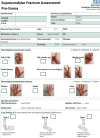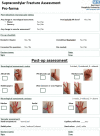Quality of Documentation in Paediatric Supracondylar Fractures: A Quality Improvement Project
- PMID: 36523668
- PMCID: PMC9745387
- DOI: 10.7759/cureus.31431
Quality of Documentation in Paediatric Supracondylar Fractures: A Quality Improvement Project
Abstract
Introduction Supracondylar fractures are the most common elbow fractures in children. Their documentation and management must be done fully and correctly. This Quality Improvement Project (QIP) assessed the quality of documentation for paediatric supracondylar fractures admitted, in accordance with the British Orthopaedic Association Standards for Trauma (BOAST). Methods We present a case series of supracondylar fractures presenting to a single UK-based district general hospital from January 2018 - October 2021. We performed a quality improvement intervention starting in November 2020. The retrospective data prior to intervention (January 2018-November 2020) were deemed "pre-intervention". Prospective "post-intervention" data were collected from April to October 2021. After "pre-intervention" data analysis, an intervention in the form of a documentation proforma was developed and multidisciplinary teaching sessions were delivered. Post-intervention prospective data collection followed from April - October 2021. Results There were 48 and 26 patients in cycles one and two, respectively. The mean age was 6.4 (SD 3.5) and 6.5 (SD 2.7) years, respectively; 42/48 in cycle one and all 26/26 in cycle two required operative management. The mean time to surgery was 1.3 and 0.96 days, respectively. Post-intervention, cycle two showed a reduction in patients with "no neurovascular documentation" pre-reduction (17% vs 12%) and an increase in patients documented as having "neurovascular status intact" (NVI) (44% vs 69%). In post-operative documentation, there was an improvement in documentation with 73% of patients having a post-operative neurovascular assessment documented, versus 50% in the pre-intervention cohort. Conclusion This QIP provided some early improvement in the documentation but with room for future progress as the project continues. It showed proformas can be an effective tool in implementing positive change. It also highlights the need for continuous clinical education across the multidisciplinary teams managing trauma.
Keywords: boast guidelines; elbow trauma; fracture in a child; humeral fracture; supracondylar fractures.
Copyright © 2022, Sibanda et al.
Conflict of interest statement
The authors have declared that no competing interests exist.
Figures







References
-
- A 10-year study of the changes in the pattern and treatment of 6,493 fractures. Cheng JC, Ng BK, Ying SY, Lam PK. https://pubmed.ncbi.nlm.nih.gov/10344317/ J Pediatr Orthop. 1999;19:344–350. - PubMed
-
- Upper extremity fractures in children - prospective epidemiological study of tertiary medical institutes. Lee SH, Kim HW, Song KS. J Korean Orthop Assoc. 2007;42:270–275.
-
- Etiology of supracondylar humerus fractures. Farnsworth CL, Silva PD, Mubarak SJ. https://pubmed.ncbi.nlm.nih.gov/9449099/ J Pediatr Orthop. 1998;18:38–42. - PubMed
-
- Increased severity of type III supracondylar humerus fractures in the preteen population. Fletcher ND, Schiller JR, Garg S, et al. J Pediatr Orthop. 2012;32:567–572. - PubMed
LinkOut - more resources
Full Text Sources
Miscellaneous
